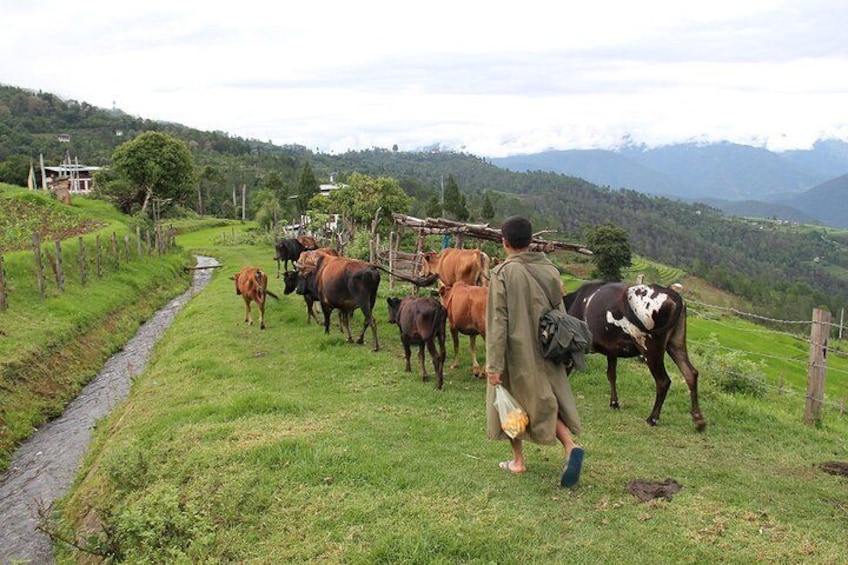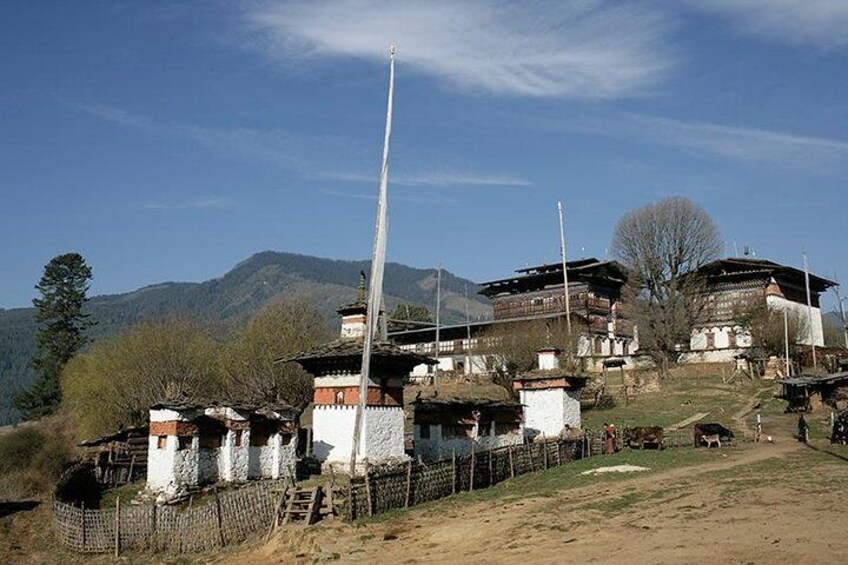Members save 10% or more on over 100,000 hotels worldwide when you’re signed in





10 Days Essence of BHUTAN
Features
- Free cancellation available
- 10d
- Mobile voucher
- Instant confirmation
Overview
On this 10-day journey covering 4 western and 2 central districts of Bhutan, we’ll get you up-close and personal with the local people, eat and live like a local, broaden your adventure by going beyond tourist activities and enjoy experiences that are truly authentic and deeply immersive that will leave you with memories for a lifetime. You will explore the essence of this magical Kingdom with a private expert guide and discover happiness amidst stunning landscapes and majestic eastern Himalayan Mountain ranges and pristine natural environment that made Bhutan the only carbon-negative country in the world.
Hidden by the staggering mountains of the Himalayas, Bhutan chose to remain in self-imposed isolation until it opened its door to the outside world in the 1960s and to this day, it still remains largely untouched by the worldly influence and holds strongly on to its age-old traditions.
Activity location
- National Museum of Bhutan འབྲུག་གི་འགྲེམས་སྟོན་ཁང་།
- Paro, Paro, Bhutan
Meeting/Redemption Point
- National Museum of Bhutan འབྲུག་གི་འགྲེམས་སྟོན་ཁང་།
- Paro, Paro, Bhutan
Check availability
10 Days Essence of BHUTAN in English
- 10d
- Opening hours: Sat 7:00-18:00
- English
Pickup included
What's included, what's not
- All internal taxes for the services listed above
- Medical treatment at a hospital in Bhutan if you sustain injuries while in Bhutan
- All ground transportation including round trip airport transfers
- All meals (breakfast, lunch & dinner) and light snacks
- Experienced English-speaking licensed tour guide.
- Entry fee for National Museum
- Twin-sharing accommodations at 3-star hotels certified by Tourism Council of Bhutan.
- Visa Fee & Processing. You'll receive your e-Visa within 4-5 business days.
- Travel insurance is highly recommended.
- International flights. Let us know if you need help with arranging flights to and from Bhutan.
- Alcoholic beverages, laundry services, telephone call charges
- Gratuity to guide and driver
- Emergency evacuation
- Guide speaking other major languages can be arranged for an additional fee.
- Any other expenses of personal nature
- All Entry fees except for National Museum
Know before you book
- Suitable for all physical fitness levels
- This tour can be customized and run on a private basis just for you and your group.
- We highly recommend booking at least a few months before the departure date so that we have enough time to ensure the flights are available. If you already have flight tickets to and from Bhutan, we can take bookings up to a week before the departure date. To process visa, it only takes 4-5 business days.
- There are only two airlines that connect Bhutan with the outside world and so securing air tickets can be difficult especially during the months of high season. Currently, Bhutan is connected with these cities - Bagdogra, Bangkok, Delhi, Dhaka, Guwahati, Kathmandu, Kolkata, Singapore. We recommend you book your international flights a few months in advance especially if you plan to visit during the high season months of March to May and September to November. If you need help in arranging flights to/from Bhutan, please let us know much in advance.
- After you book the tour, kindly send us clear passports copies of all the participants. A biodata page including the machine-readable zone must be seen clearly. Passports should have a minimum of 6 MONTHS validity from the day you depart from Bhutan. You may also want to check the passport requirements by your next destination country after Bhutan. A copy of your e-Visa will be emailed to you once it is approved. It only takes 4-5 business days to get visa approval and it is 100 percent guaranteed as long as we receive clear passport copies of all the participants. The actual visa will be stamped on your passport upon arrival. Send the passport copies to the Local Supplier E-mail address
- Youth between the ages of 13-18 MUST send us a copy of their valid Student Photo ID Card/Document to keep the discounted price. Without a copy of valid Student Photo ID Card/document, the full adult price will apply.
- Participants below the age of 18 years old MUST be accompanied by at least one full-paying adult.
Activity itinerary
Day 1: Arrive Paro International Airport / Transfer to the capital city Thimphu (2334m)
- 4 stops
- Meals: lunch, snacks
- Accommodation: Dinner and overnight at Kuenphen Rabten Resort or Bhutan Mandala Resort
National Museum of Bhutan འབྲུག་གི་འགྲེམས་སྟོན་ཁང་།
- 1h
- Admission ticket not included
Thimphu
- 2h
Bhutan Postal Museum
- 1h
- Admission ticket not included
Gagyel Lhundrup Weaving Centre
- 45m
- Admission ticket included
Day 2: Sightseeing in Thimphu / Transfer to Punakha Valley (1200m)
- 7 stops
- Meals: breakfast, lunch, snacks
- Accommodation: Dinner and overnight at Aum Leki Wangmo Homestay for a unique experience with the local family.
Buddha Dordenma
- 45m
Changangkha Lhakhang
- 45m
- Admission ticket not included
Royal Takin Preserve
- 1h
- Admission ticket not included
National Institute for Zorig Chusum
- 45m
- Admission ticket not included
Changlimithang Stadium & Archery Ground
- 30m
Dochula Pass
- 2h
- Admission ticket included
Chimi Lhakhang Temple
- 1m
- Admission ticket not included
Day 3: Punakha / Transfer to Trongsa in Central Bhutan (2200m)
- 2 stops
- Meals: breakfast, lunch, snacks
- Accommodation: Dinner and overnight at Norbu Linka Resort or Tashi Ninjay Guest House.
Khamsum Yulley Namgyal Chorten
- 2h 30m
Punakha Dzong
- 5h
- Admission ticket not included
Day 4: Trongsa / Transfer to Bumthang Valley in Central Bhutan (2700m)
- 4 stops
- Meals: breakfast, lunch, snacks
- Accommodation: Dinner and overnight at Kaila Guest House or Hotel Ugyenling
Trongsa
- 45m
Taa-Dzong བལྟ་རྫོང་།
- 30m
- Admission ticket not included
Bumthang
- 3h
Tamshing Lhakhang གཏམ་ཞིང་ལྷ་ཁང་།
- 2h
- Admission ticket not included
Day 5: Full day exploring the valley of Bumthang
- 3 stops
- Meals: breakfast, lunch, snacks
- Accommodation: Dinner and overnight at Kaila Guest House or Hotel Ugyenling
Burning Lake
- 3h
- Admission ticket included
Ogyen Choling Palace Museum
- 3h
- Admission ticket not included
Kurjey Lhakhang སྐུ་རྗེས་ལྷ་ཁང་།
- 45m
- Admission ticket not included
Day 6: Bumthang / Transfer to Phobjikha valley (3000m)
- 3 stops
- Meals: breakfast, lunch, snacks
- Accommodation: Dinner and overnight at Yue-Loki Guest House or Phobjikha Resort
Phobjikha Valley
- 5h
Thru Epang Palace ཁྲུས་སྤང་ཕོ་བྲང་།
- 30m
- Admission ticket not included
Gangtey Monastery
- 45m
- Admission ticket not included
Day 7: Gangtey Nature Hike in Phobjikha / Transfer back to Paro valley (2200m)
- 2 stops
- Meals: breakfast, lunch, snacks
- Accommodation: Dinner and overnight at Lhayhuel Resort or Bhutan Mandala Resort.
Gangtey Nature Trail
- 7h
- Admission ticket included
Kyichu Lhakhang
- 30m
- Admission ticket not included
Day 8: Drive to Chelela Pass at 3900m and do a short hike to a Nunnery
- 1 stop
- Meals: breakfast, lunch, snacks
- Accommodation: Dinner and overnight at Lhayhuel Resort or Bhutan Mandala Resort.
Chele La Pass
- 5h
Day 9: Hike to the famous Paro Taktsang and later visit a beautiful farmhouse
- 2 stops
- Meals: breakfast, lunch, snacks
- Accommodation: Dinner and overnight at Lhayhuel Resort or Bhutan Mandala Resort.
Paro Taktsang
- 5h
- Admission ticket not included
Sonam's Homestay
- 3h
- Admission ticket included
Day 10: Transfer to Paro International Airport
- 1 stop
- Meals: breakfast
- Accommodation: Not included
Paro International Airport
Location
Activity location
- National Museum of Bhutan འབྲུག་གི་འགྲེམས་སྟོན་ཁང་།
- Paro, Paro, Bhutan
Meeting/Redemption Point
- National Museum of Bhutan འབྲུག་གི་འགྲེམས་སྟོན་ཁང་།
- Paro, Paro, Bhutan